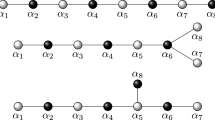Abstract.
The purpose of this paper is twofold: first, to explain Gian-Carlo Rota’s work on invariant theory; second, to place this work in a broad historical and mathematical context. Rota’s work falls under three specific cases: vector invariants, the invariants of binary forms, and the invariants of skew-symmetric tensors. We discuss each of these cases and show how determinants and straightening play central roles. In fact, determinants constitute all invariants in the vector case; for binary forms and skew-symmetric tensors, they constitute all invariants when invariants are represented symbolically. Consequently, we explain the symbolic method both for binary forms and for skew-symmetric tensors, where Rota developed generalizations of the usual notion of a determinant. We also discuss the Grassmann algebra, with its two operations of meet and join, which was a theme which ran through Rota’s work on invariant theory almost from the very beginning.
Similar content being viewed by others
Author information
Authors and Affiliations
Corresponding author
Additional information
To the memory of Gian-Carlo Rota
Rights and permissions
About this article
Cite this article
Grosshans, F.D. The work of Gian-Carlo rota on invariant theory. Algebra univers. 49, 213–258 (2003). https://doi.org/10.1007/s00012-003-1827-z
Received:
Accepted:
Issue Date:
DOI: https://doi.org/10.1007/s00012-003-1827-z




